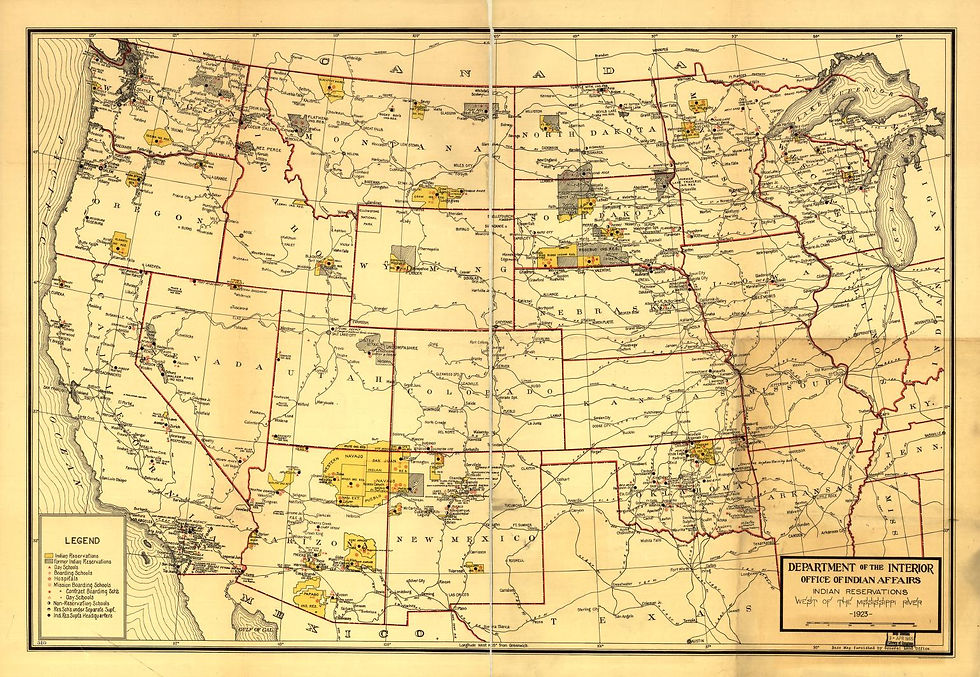Red River Original Tribes
- Robin Cole-Jett

- Sep 5, 2023
- 4 min read
Four major tribes — the Red River Originals — inhabited the Red River Valley of the Southwest before and during European invasion. The Caddos, Wichitas, Kiowas and the Comanches dominated the region and its history for centuries, if not millennia.
After European contact, fortunes for Native Americans changed drastically. The Red River Valley reflected this through the migration of the Shawnees, the invasions of the Osages, and the alliances with the Tonkawas. In the American period, the Red River Valley became home to two tribes, the Choctaws and Chickasaws, removed from their homelands east of the Mississippi River via the Indian removal acts, culminating in the Federal Indian Removal Act of 1830.
Villages and Tribal Affiliation
What scholars lump into "tribes" (and now adopted by the nations themselves) makes history easy to color-coordinate and code, but that doesn't mean things are as simple as all that. Each "tribe" was really a village, sometimes a group of only one clan or a place with several families living in each other's proximity. Their tribal names come from European accounts, not their own.
The Red River Valley was originally home to the people known as the Caddos. For hundreds of years before the 14th and 15th centuries, Caddo villagers would pay tribute to a hierarchy of spirtual leaders inside cities that once resided along the Arkansas, Canadian, and Red Rivers. This commonality led to a kinship ties even beyond "decentralization," when cities like Spiro were abandoned and spiritual leaders began to reside in their individual villages.
Limited Scopes
Because the original inhabitants of the Red River Valley did not leave a written record of their own, it has often been hard to categorize the people as being part of a "nation" or, at least, a "confederacy." The first written accounts of the Caddos, for example, came from the Spanish, who viewed the villages they encountered as resources to exploit. This point of view was evidenced by other European chroniclers, who documented the Native Americans they encountered in the confines of how useful/beneficial they could be to them. European chroniclers of the original inhabitants of the Red River Valley include Spanish, French, and Anglo-American accounts, as this area was never under English rule.
Archaeology
Scholarly attempts at reconstructing the history of the aboriginal inhabitants of the Red River rely on several clues that help to piece together incomplete but workable, broad understandings. Archaeological digs and artifacts provide some context. The archaeological record can be haphazard, as several, possibly important sites in the Red River Valley have been destroyed over the years through neglect, ambivalence, or apathy. For example, entire mound cities once occupied by people of the Caddos have been destroyed by farming or by relic hunters. The relics left behind by the Comanches were often purposely destroyed by ranchers. The cultural touchstones of the Wichitas were outright stolen; one of their major cities near Wichita, Kansas became a golf course.
Still, scientific surveys of sites that have been explored reveal certain key factors: that at one point, the Caddos and Wichitas belonged to a much more centralized culture with major ceremonial cities that acted as religious centers and trade conduits. Prior to 1492, something happened (there is no consensus as to WHAT happened) that made the tribes decentralize and localize. It may have been as simple as villages refusing to pay tributes to the cities any longer, or it may have been a changing climate due to the mini-ice age that occurred at the same time.
De-centralization allowed emerging powers, like the Comanches and the Kiowas, access to the area. By the 17th and 18th centuries, the power dynamic shifted further, and the Europeans came to dominate the region, leading to clashes with the emergent Comanche Empire and the faltering Caddoan and Wichitan domains.
Linguistic Kinships
Due to the uncertainties and incomplete records that archeology provides, anthropologists rely on language to understand how tribes are related to each other. Caddos, for example, have a distinctive language base in which the languages for the Nasonis, Kaddahadachos, Adaes, Natchitoches, Nacogdoches, Hasinais, and others are related. Their language influenced Wichita linguistics, that villages occupied by the Tawakonis, Wacos, Taovayans, Tehuacanas and Keechis (among several others) held in common. The Comanche language differs substantially from Caddoan: Comanche is a branch of the Shoshone linguistic group, a tribal affiliation that stems from Wyoming. All of these language bonds help to explain the historical origins of the Red River Valley tribes, too.
Oral Histories
Ultimately, a true understanding of the history of the original Red River Valley inhabitants relies on their own stories. These consist of oral traditions and tales that have been passed down but which, unfortunately, have also been neglected due to policies that insisted on the “Americanization" of Indians that led to the destruction of tribal memories. Americanization programs included forcing children to stop using their language, wear western clothing, and ignore their religion, customs, and traditions on threat of punishment. Some of these stories remain and have been recorded, while others still exist as family stories that are passed down through the generations. The oral versions of the stories are true "living histories," as subsequent story tellers embellish, add, change, or take away some parts of a story to make it their own.
Tribal Impacts
Today, the Caddo, Wichita, and Comanche tribes are no longer decentralized and scattered - they exist as nations, with constitutions, courts, and laws. Their national forgiveness towards the U.S. is formidable, too. Native Americans make up a disproportionate number of veterans and active duty military members relative to their population numbers. In fact, if it hadn't been for the Comanche and Choctaw code talkers, the U.S. would not have fared as well during both world wars.












Comments